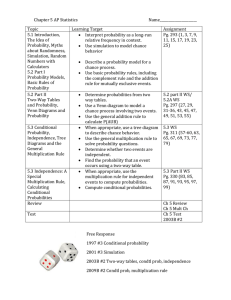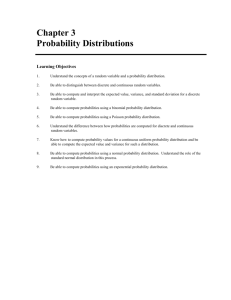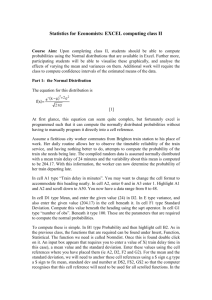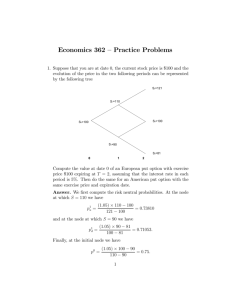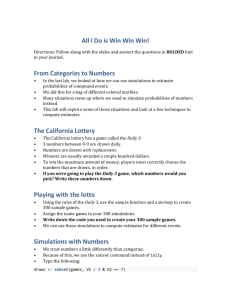Computing Probabilities: Set Concepts and Venn Diagrams
advertisement
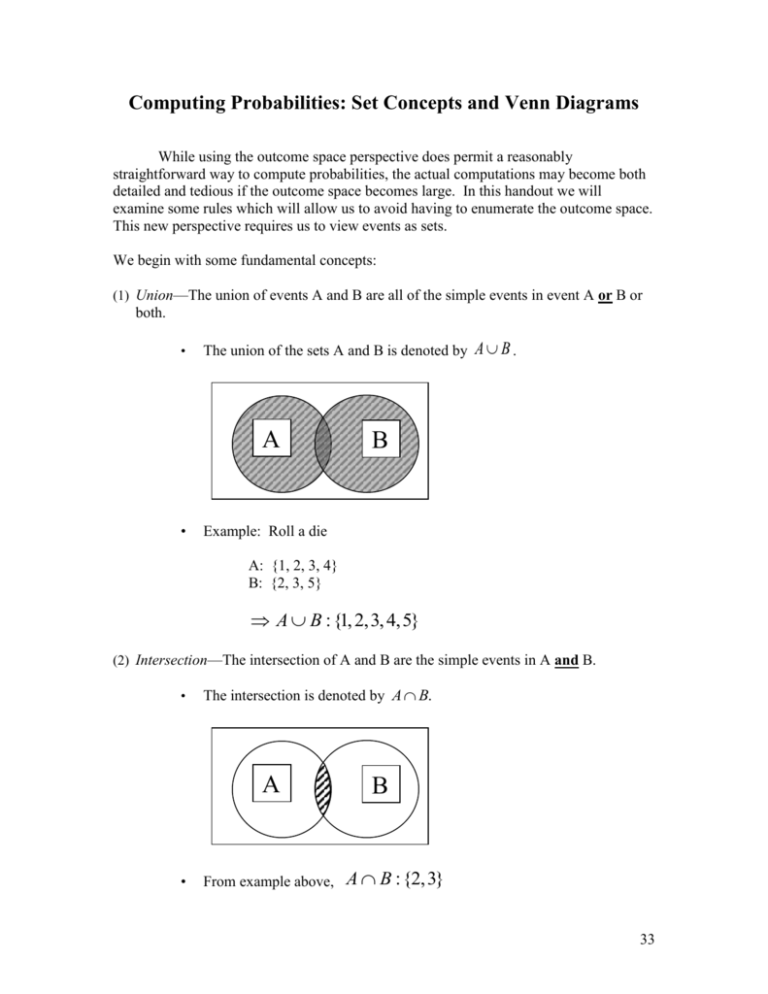
Computing Probabilities: Set Concepts and Venn Diagrams
While using the outcome space perspective does permit a reasonably
straightforward way to compute probabilities, the actual computations may become both
detailed and tedious if the outcome space becomes large. In this handout we will
examine some rules which will allow us to avoid having to enumerate the outcome space.
This new perspective requires us to view events as sets.
We begin with some fundamental concepts:
(1) Union—The union of events A and B are all of the simple events in event A or B or
both.
•
The union of the sets A and B is denoted by A B .
A
•
B
Example: Roll a die
A: {1, 2, 3, 4}
B: {2, 3, 5}
A B : {1, 2, 3, 4, 5}
(2) Intersection—The intersection of A and B are the simple events in A and B.
•
The intersection is denoted by A B.
A
•
From example above,
B
A B : {2, 3}
33
Using set concepts to compute probabilities
(1) The addition rule—To compute the probability of
A B , compute
P{ A B} P{ A} P{B} P{ A B}
Example: A 2004 issue of the Wall Street Journal reported that 40% of their
subscribers read Time, 32% read Forbes, and 11% read both. What is the
probability that a subscriber reads either Time or Forbes or both?
Let
A:
B:
the subscriber reads Time
the subscriber reads Forbes
Then P{A} =
P{B} =
P{ A B}
P{ A B}
(2) The multiplication rule to compute
P{ A B}
We first seek to define a concept called conditional probability. Consider the
outcome space for a family with two children:
Let
(M, M)
(M, F)
(F, M)
(F, F)
A:
the family has at least one male child
B:
the family has exactly two male children
What is P{A}?
34
P{B}?
P{ A B}?
Now suppose that event A has occurred. What had to have happened?
Are these outcomes equally likely to occur?
What is the probability of any of the simple outcomes?
We will write {B|A} to indicate name an event B assuming that A has occurred. What is
P{B|A}?
One can typically compute such probabilities by referring to the outcome space restricted
to A. Such a probability is called a conditional probability. Recalling the Venn
Diagram:
A
B
We can see that if A has occurred, the only way for B to occur is for A B to occur.
Now remembering that probabilities act just like areas, the chance of A B occurring
relative to the restricted outcome space A is just the ratio of the area of A B to the
area of A. Thus
P{B | A}
P{ A B}
P{ A}
35
In our earlier example:
P{B|A} =
Notice that the definition of conditional probability gives a way to compute P{ A B} if
you have a conditional probability. We thus have the multiplication rules:
P{ A B} = P{B|A} P{A} or
P{ A B} = P{A|B} P{B}
Homework for computing probabilities of unions and intersections
An experiment is performed by rolling two dice and noting the values of the top surfaces.
Define the events A = {the sum of the values is 6 or 8}, and B = {the difference of the
two values is 2}.
(1) Compute P{A} and P{B}.
(2) What is the probability that both A and B occur? List all of the outcomes that make
A and B occur at the same time.
(3) What is the probability that A or B occurs? How many outcomes make A or B
occur?
(4) Assuming A occurs, what is the probability that B occurs? Answer this question by
considering the restricted outcome space. How many simple events are in the
restricted outcome space? How many of those make B occur?
(5) Answer part (4) using the multiplication rule.
(6) Assuming B occurs, what is the probability that A occurs? Answer this question by
considering the restricted outcome space.
(7) Answer part (6) using the multiplication rule.
36
37

